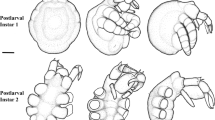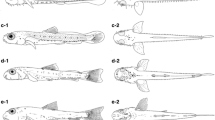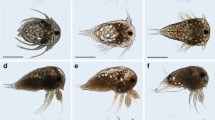Abstract
Male specimens of the sea spider species Nymphon unguiculatum, carrying eggs, larvae and postlarvae in various stages of development, were collected off the South Shetland Island at water depths between 112 and 472 m in austral summer 2006/2007. Here, we describe the external morphology of four postembryonic stages (protonymphon, instar 1, instar 2, and instar 3) carried by these specimens. We found that (1) protonymphon larvae hatch from the eggs; (2) larvae and postlarval stages have yolk reserves and are characterized by a relatively large size (average body lengths of 0.46, 0.55, 0.65 and 0.73 mm in the successive stages); (3) postlarvae remain on the ovigerous legs of males during several moults; (4) a spinning apparatus is present; (5) the development of walking legs is sequential. The larval and postlarval development of N. unguiculatum is compared with that known from other pycnogonid species.







Similar content being viewed by others
References
Arnaud F, Bamber R (1987) The biology of Pycnogonida. Adv Mar Biol 24:1–96
Bain BA (2003a) Larval types and a summary of postembryonic development within the pycnogonids. Invertebr Reprod Dev 43:193–222
Bain BA (2003b) Postembryonic development in the pycnogonid Austropallene cornigera (Family Callipallenidae). Invertebr Reprod Dev 43:181–192
Bain BA, Govedich FG (2004) Courtship and mating behavior in the Pycnogonida (Chelicerata: Class Pycnogonida): a summary. Invertebr Reprod Dev 43:63–79
Bamber RN (2007) A holistic re-interpretation of the phylogeny of the Pycnogonida Latreille, 1810 (Arthropoda). Zootaxa 1668:295–312
Behrens W (1984) Larvenentwicklung und Metamorphose von Pycnogonum litorale (Chelicerata, Pantopoda). Zoomorphology 104:266–279
Bogomolova EV (2007) Larvae of three sea spider species of the Genus Nymphon (Arthropoda: Pycnogonida) from the White Sea. Russ J Mar Biol 33:145–160
Bogomolova EV, Malakhov VV (2003) Larvae of sea spiders (Arthropoda, Pycnogonida) of the White Sea. Entomol Rev 82:213–227
Bogomolova EV, Malakhov VV (2004) Fine morphologyof sea spider larvae (Arthropoda, Pycnogonida) of the White Sea. Zool Bespozvon 1:3–28
Bogomolova EV, Malakhov VV (2006) Lecithotrophic protonymphon is a special type of postembryonic development of sea spiders (Arthropoda, Pycnogonida). Dokl Biol Sci 409:328–331
Bouvier EL (1913) Pycnogonides du pourquoi Pas? In: Calman WT (ed) Deuxième Expédition Antarctique française (1908–1910) 6. Masson, Paris, pp 1–169
Calman WT (1915) Pycnogonida. British antarctic (Terra Nova) expedition, 1910. Zool 3:1–74
Cano E, López-González PJ (2009) Novel mode of postembryonic development in Ammothea genus (Pycnogonida: Ammotheidae) from Antarctic waters. Sci Mar 73:541–550
Child CA (1995) Antarctic and Subantarctic Pycnogonida III. The Family Nymphonidae. In: Cairns S D (ed) Biology of the Antarctic Seas XXIII. Antarct Res Ser 69:1–68
Gillespie JM, Bain BA (2006) Postembryonic development of Tanystylum bealensis (Pycnogonida, Ammotheidae) from Barkley Sound, British Columbia, Canada. J Morphol 267:308–317
Gordon I (1932) Pycnogonida. Discov Rep 6:1–138
Gordon I (1944) Pycnogonida. Rep B A N Z Antarct Res Exped 5:1–172
Gutt J (2008) The expedition ANTARKTIS-XXIII/8 of the research vessel “Polarstern” in 2006/2007. Ber Polarforsch 569:1–153
Hedgpeth JW (1947) On the evolutionary significance of the Pycnogonida. Smithson Misc Coll 106:1–54
Hodgson TV (1907) Pycnogonida. National Antarctic Expedition 1901–1904. Reports of the National Antarctic expedition of (1904–1907). Nat Hist 3:1–172
Hodgson TV (1915) The Pycnogonida collected by “Gauss” in the Antarctic Regions, 1901–1903. Prelim Rep Ann Mag Nat Hist 15:141–149
Hodgson TV (1927) Die pycnogoniden der deutschen südpolar-expedition 1901–1903. Zool 19:303–358
Lovely EC (2005) The life history of Phoxichilidium tubulariae (Pycnogonida; Phoxichilidiidae). Northeast Nat 12:77–92
Morgan TH (1891) A Contribution to the embryology and phylogeny of the pycnogonids. Dissertation, John Hopkins University
Munilla T (2001) A new species of Ammothea (Pycnogonida) and other pycnogonids from Livingston Island and surrounding waters (South Shetland Islands, Antarctica). Antarct Sci 13:144–149
Munilla T, Soler A (2009) Check-list of the pycnogonids from Antarctic and sub-Antarctic waters: zoogeographic implications. Antarct Sci 21:99–111
Nakamura K (1981) Post-embryonic development of a pycnogonid, Propallene longiceps. J Nat Hist 15:49–62
Ohshima H (1933) Young pycnogonids found parasitic on nudibranchs. Annot Zool Jpn 14:61–66
Okuda S (1940) Metamorphosis of a pycnogonid parasitic in a hydromedusa. J Fac Sci Hokkaido Imp Univ Zool 7:73–86
Staples DA, Watson JE (1987) Associations between pycnogonids and hydroids. In: Bouillion J (ed) Modern trends in the systematics, ecology and evolution of hydroids and hydromedusa. Oxford University Press, Oxford, pp 215–226
Vilpoux K, Waloszek D (2003) Larval development and morphogenesis of the sea spider Pycnogonum litorale (Ström, 1762) and the tagmosis of the body of Pantopoda. Arthropod Struct Dev 32:349–383
Wilhelm E, Bückmann D, Tomaschko KH (1997) Life cycle and population dynamics of Pycnogonum litorale (Pycnogonida) in a natural habitat. Mar Biol 129:601–606
Acknowledgments
The authors would like to thank the valuable assistance of the officers and crew of the R/V Polarstern, and many colleagues on board during the Polarstern ANT XXIII/8 cruises. We take this opportunity to extend our thanks to the cruise leaders and steering committee of the cruises, especially Julian Gutt (Alfred Wegener Institut, Bremerhaven) and Enrique Isla (Instituto de Ciencias del Mar, CSIC, Barcelona), who kindly facilitated the work on board and for the opportunity to collaborate in this Antarctic programme. We also acknowledge Marika di Meglio for her assistance during the first moments of this study. Support for this work was provided by the Spanish CICYT project POL2006-06399/CGL (CLIMANT). Mr. Tony Krupa is thanked for reviewing the English version.
Author information
Authors and Affiliations
Corresponding author
Rights and permissions
About this article
Cite this article
Sánchez, E.C., López-González, P.J. Postembryonic development of Nymphon unguiculatum Hodgson 1915 (Pycnogonida, Nymphonidae) from the South Shetland Islands (Antarctica). Polar Biol 33, 1205–1214 (2010). https://doi.org/10.1007/s00300-010-0810-3
Received:
Revised:
Accepted:
Published:
Issue Date:
DOI: https://doi.org/10.1007/s00300-010-0810-3




